UGB222 Management Accounting: Costing, Variance Analysis, and BEP
VerifiedAdded on 2023/06/18
|11
|1723
|139
Homework Assignment
AI Summary
This assignment covers key concepts in management accounting, including cost estimation using the high-low method, income statement preparation under absorption and marginal costing, variance analysis (material price, material usage, labor rate, and labor efficiency), break-even point calculations (in units and value), and contribution margin ratio analysis. The high-low method is used to determine variable and fixed costs for St. James Hospital. Income statements are prepared under both absorption and marginal costing methods. Variance analysis is performed to assess material and labor cost control. Break-even points are calculated in both units and value. The contribution margin ratio's role in business planning is also discussed. Desklib offers a wealth of resources, including past papers and solved assignments, to aid students in their studies.
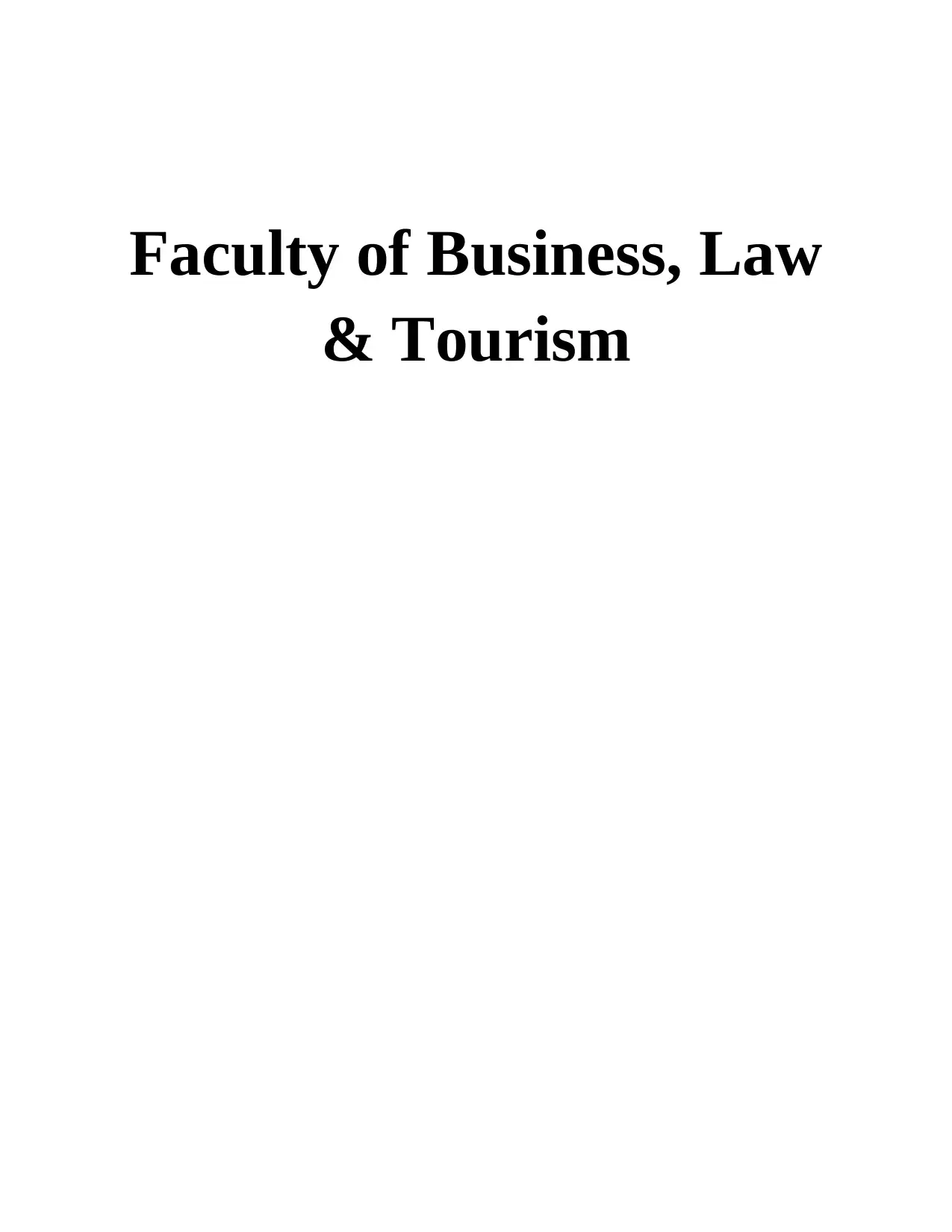
Faculty of Business, Law
& Tourism
& Tourism
Paraphrase This Document
Need a fresh take? Get an instant paraphrase of this document with our AI Paraphraser

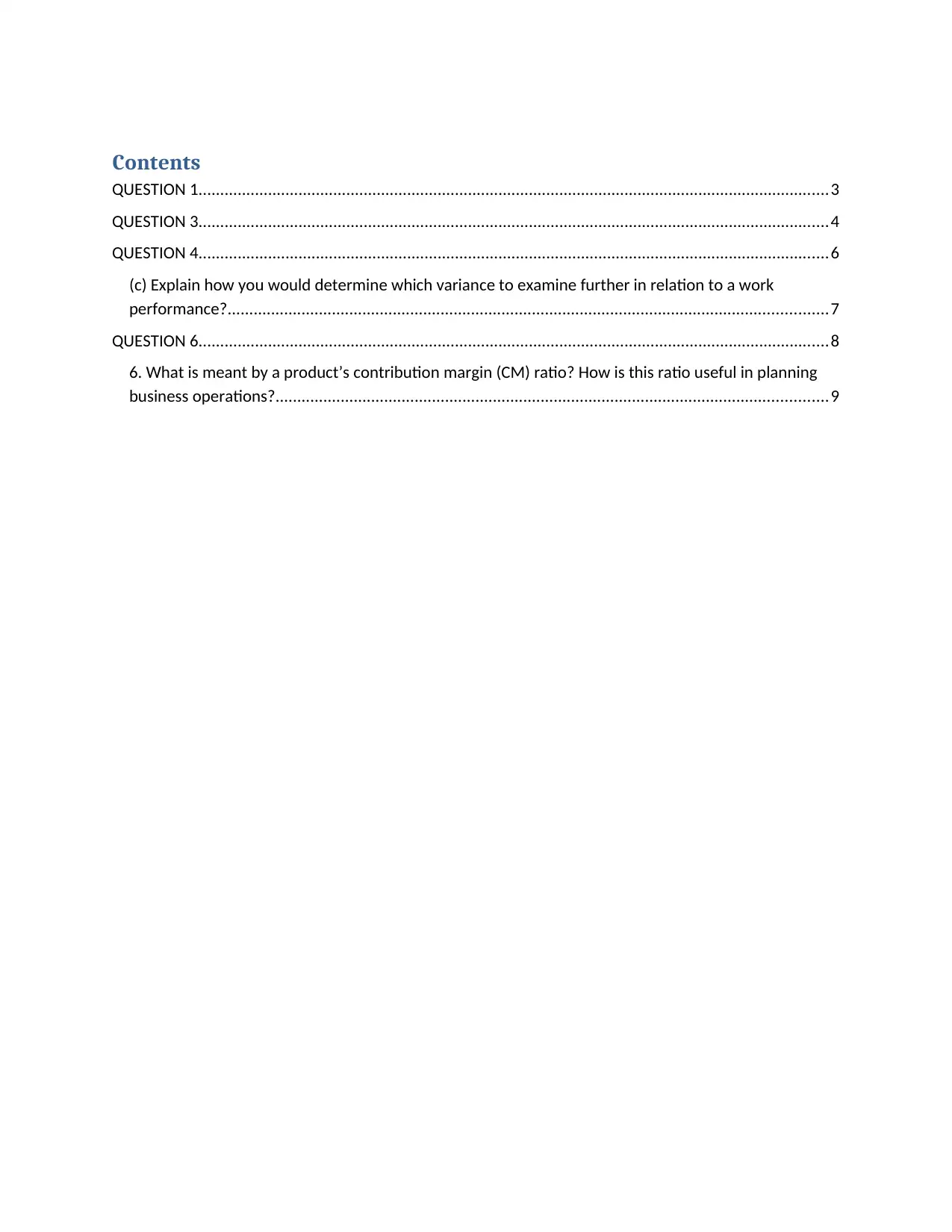
Contents
QUESTION 1.................................................................................................................................................3
QUESTION 3.................................................................................................................................................4
QUESTION 4.................................................................................................................................................6
(c) Explain how you would determine which variance to examine further in relation to a work
performance?..........................................................................................................................................7
QUESTION 6.................................................................................................................................................8
6. What is meant by a product’s contribution margin (CM) ratio? How is this ratio useful in planning
business operations?...............................................................................................................................9
QUESTION 1.................................................................................................................................................3
QUESTION 3.................................................................................................................................................4
QUESTION 4.................................................................................................................................................6
(c) Explain how you would determine which variance to examine further in relation to a work
performance?..........................................................................................................................................7
QUESTION 6.................................................................................................................................................8
6. What is meant by a product’s contribution margin (CM) ratio? How is this ratio useful in planning
business operations?...............................................................................................................................9
⊘ This is a preview!⊘
Do you want full access?
Subscribe today to unlock all pages.

Trusted by 1+ million students worldwide
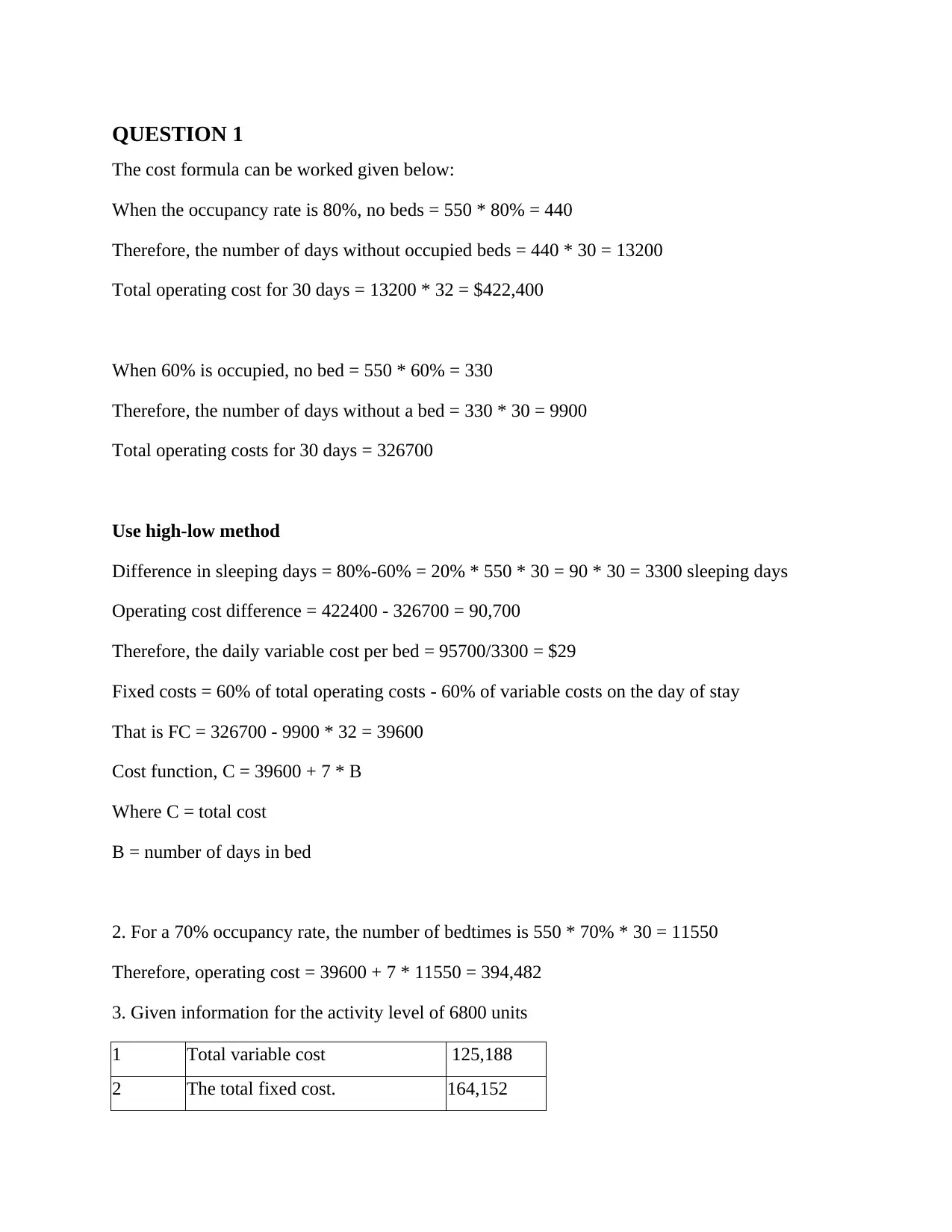
QUESTION 1
The cost formula can be worked given below:
When the occupancy rate is 80%, no beds = 550 * 80% = 440
Therefore, the number of days without occupied beds = 440 * 30 = 13200
Total operating cost for 30 days = 13200 * 32 = $422,400
When 60% is occupied, no bed = 550 * 60% = 330
Therefore, the number of days without a bed = 330 * 30 = 9900
Total operating costs for 30 days = 326700
Use high-low method
Difference in sleeping days = 80%-60% = 20% * 550 * 30 = 90 * 30 = 3300 sleeping days
Operating cost difference = 422400 - 326700 = 90,700
Therefore, the daily variable cost per bed = 95700/3300 = $29
Fixed costs = 60% of total operating costs - 60% of variable costs on the day of stay
That is FC = 326700 - 9900 * 32 = 39600
Cost function, C = 39600 + 7 * B
Where C = total cost
B = number of days in bed
2. For a 70% occupancy rate, the number of bedtimes is 550 * 70% * 30 = 11550
Therefore, operating cost = 39600 + 7 * 11550 = 394,482
3. Given information for the activity level of 6800 units
1 Total variable cost 125,188
2 The total fixed cost. 164,152
The cost formula can be worked given below:
When the occupancy rate is 80%, no beds = 550 * 80% = 440
Therefore, the number of days without occupied beds = 440 * 30 = 13200
Total operating cost for 30 days = 13200 * 32 = $422,400
When 60% is occupied, no bed = 550 * 60% = 330
Therefore, the number of days without a bed = 330 * 30 = 9900
Total operating costs for 30 days = 326700
Use high-low method
Difference in sleeping days = 80%-60% = 20% * 550 * 30 = 90 * 30 = 3300 sleeping days
Operating cost difference = 422400 - 326700 = 90,700
Therefore, the daily variable cost per bed = 95700/3300 = $29
Fixed costs = 60% of total operating costs - 60% of variable costs on the day of stay
That is FC = 326700 - 9900 * 32 = 39600
Cost function, C = 39600 + 7 * B
Where C = total cost
B = number of days in bed
2. For a 70% occupancy rate, the number of bedtimes is 550 * 70% * 30 = 11550
Therefore, operating cost = 39600 + 7 * 11550 = 394,482
3. Given information for the activity level of 6800 units
1 Total variable cost 125,188
2 The total fixed cost. 164,152
Paraphrase This Document
Need a fresh take? Get an instant paraphrase of this document with our AI Paraphraser

3 The total cost. 289340
4
The average variable cost per
unit. 18.41
5 The average fixed cost per unit. 24.14
6 The average total cost per unit. 42.55
Basic principle: Variable cost per unit remains constant and fixed cost in total remains constant.
For the activity level 7100
(a) Total variable cost: 7100 * 18.41
= 130711
(b) Total fixed cost: 164152
(c) Average variable cost per unit: 18.41
(d) Average fixed cost per unit: 24.14
(e) Average total cost per unit: 42.55
QUESTION 3
Income statement by Absorption Costing:
Particular Amount
Sale(10000*25) 250000
Less: - Cost of goods sold
Material Cost 50000
Labour Cost 30000
Variable Cost 20000
Fixed manufacturing overheads 40000 140000
4
The average variable cost per
unit. 18.41
5 The average fixed cost per unit. 24.14
6 The average total cost per unit. 42.55
Basic principle: Variable cost per unit remains constant and fixed cost in total remains constant.
For the activity level 7100
(a) Total variable cost: 7100 * 18.41
= 130711
(b) Total fixed cost: 164152
(c) Average variable cost per unit: 18.41
(d) Average fixed cost per unit: 24.14
(e) Average total cost per unit: 42.55
QUESTION 3
Income statement by Absorption Costing:
Particular Amount
Sale(10000*25) 250000
Less: - Cost of goods sold
Material Cost 50000
Labour Cost 30000
Variable Cost 20000
Fixed manufacturing overheads 40000 140000
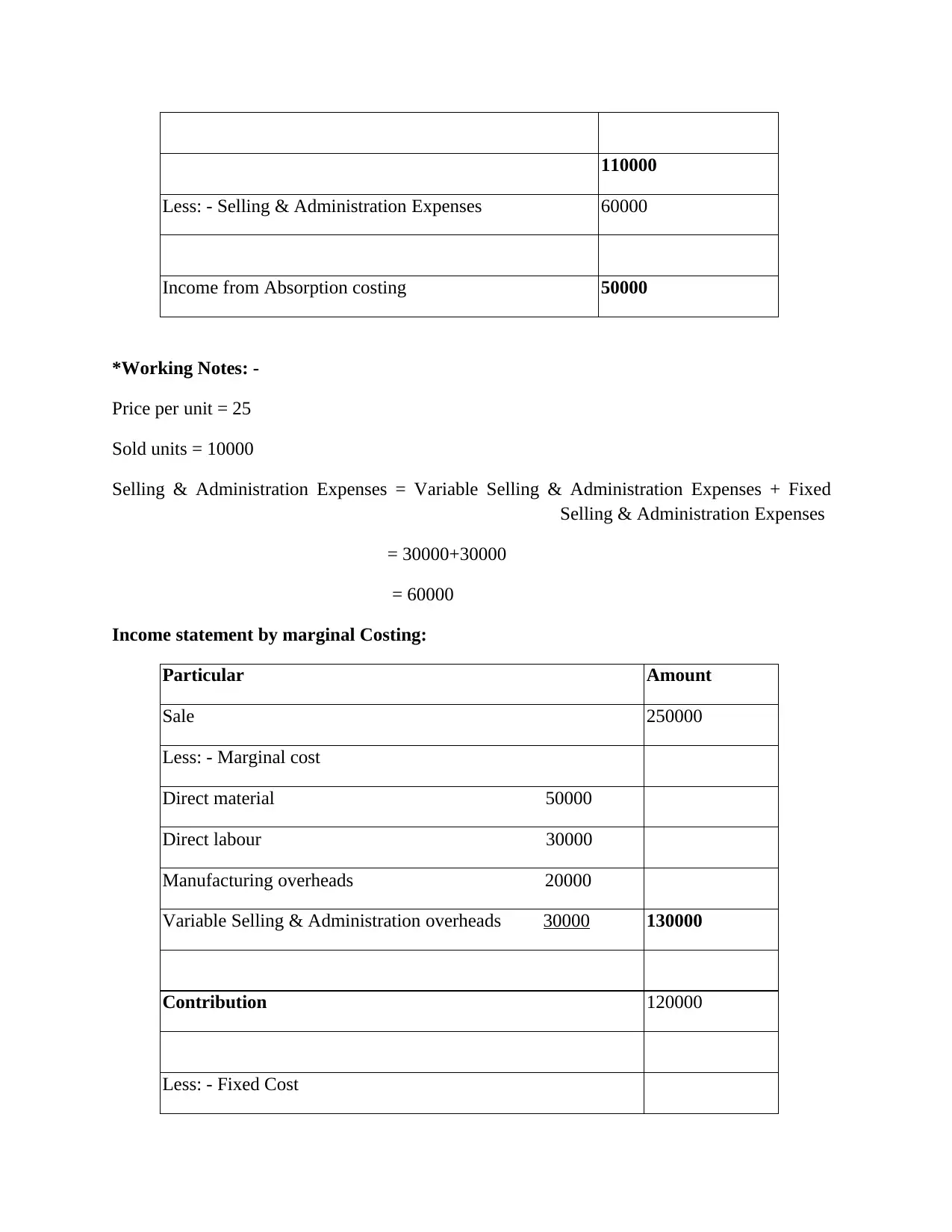
110000
Less: - Selling & Administration Expenses 60000
Income from Absorption costing 50000
*Working Notes: -
Price per unit = 25
Sold units = 10000
Selling & Administration Expenses = Variable Selling & Administration Expenses + Fixed
Selling & Administration Expenses
= 30000+30000
= 60000
Income statement by marginal Costing:
Particular Amount
Sale 250000
Less: - Marginal cost
Direct material 50000
Direct labour 30000
Manufacturing overheads 20000
Variable Selling & Administration overheads 30000 130000
Contribution 120000
Less: - Fixed Cost
Less: - Selling & Administration Expenses 60000
Income from Absorption costing 50000
*Working Notes: -
Price per unit = 25
Sold units = 10000
Selling & Administration Expenses = Variable Selling & Administration Expenses + Fixed
Selling & Administration Expenses
= 30000+30000
= 60000
Income statement by marginal Costing:
Particular Amount
Sale 250000
Less: - Marginal cost
Direct material 50000
Direct labour 30000
Manufacturing overheads 20000
Variable Selling & Administration overheads 30000 130000
Contribution 120000
Less: - Fixed Cost
⊘ This is a preview!⊘
Do you want full access?
Subscribe today to unlock all pages.

Trusted by 1+ million students worldwide
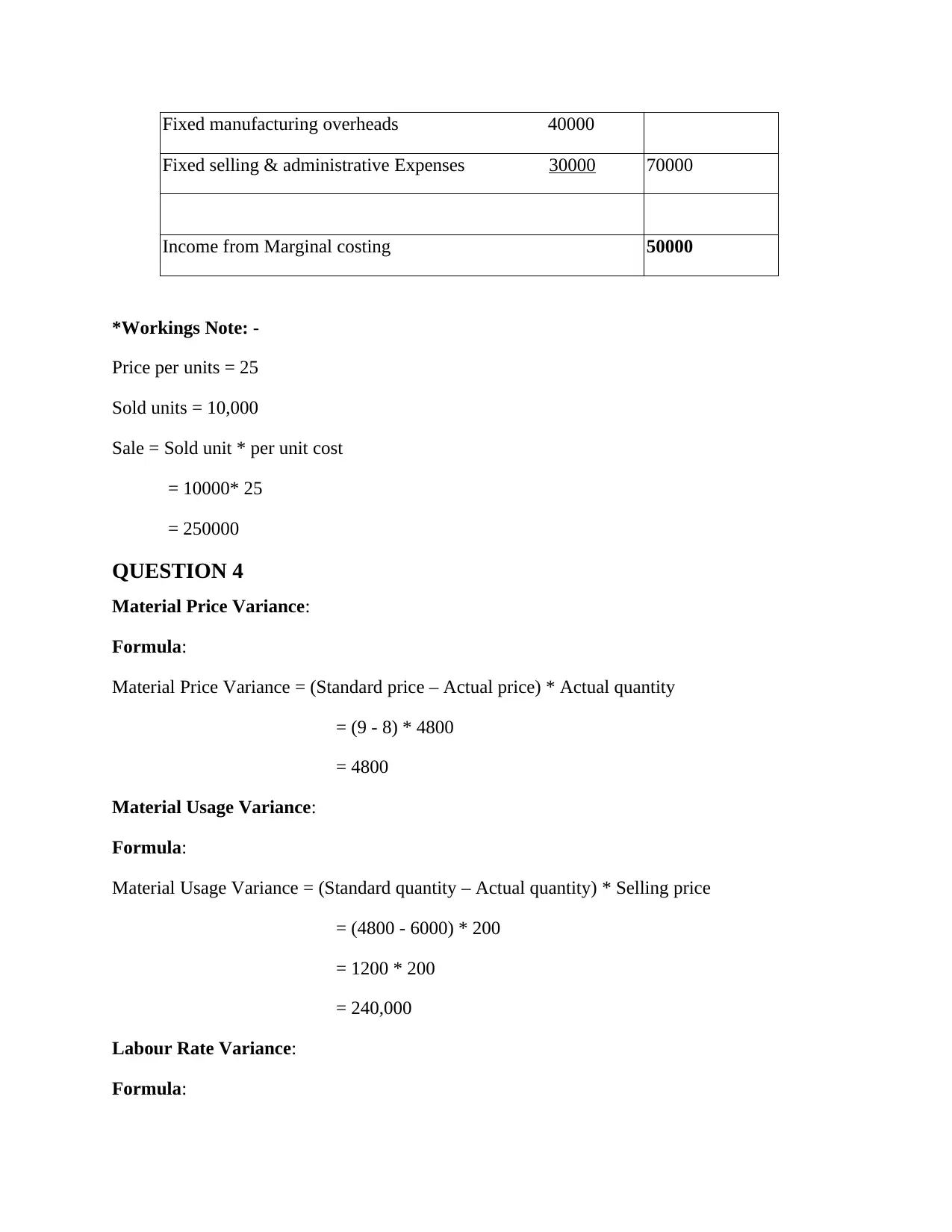
Fixed manufacturing overheads 40000
Fixed selling & administrative Expenses 30000 70000
Income from Marginal costing 50000
*Workings Note: -
Price per units = 25
Sold units = 10,000
Sale = Sold unit * per unit cost
= 10000* 25
= 250000
QUESTION 4
Material Price Variance:
Formula:
Material Price Variance = (Standard price – Actual price) * Actual quantity
= (9 - 8) * 4800
= 4800
Material Usage Variance:
Formula:
Material Usage Variance = (Standard quantity – Actual quantity) * Selling price
= (4800 - 6000) * 200
= 1200 * 200
= 240,000
Labour Rate Variance:
Formula:
Fixed selling & administrative Expenses 30000 70000
Income from Marginal costing 50000
*Workings Note: -
Price per units = 25
Sold units = 10,000
Sale = Sold unit * per unit cost
= 10000* 25
= 250000
QUESTION 4
Material Price Variance:
Formula:
Material Price Variance = (Standard price – Actual price) * Actual quantity
= (9 - 8) * 4800
= 4800
Material Usage Variance:
Formula:
Material Usage Variance = (Standard quantity – Actual quantity) * Selling price
= (4800 - 6000) * 200
= 1200 * 200
= 240,000
Labour Rate Variance:
Formula:
Paraphrase This Document
Need a fresh take? Get an instant paraphrase of this document with our AI Paraphraser
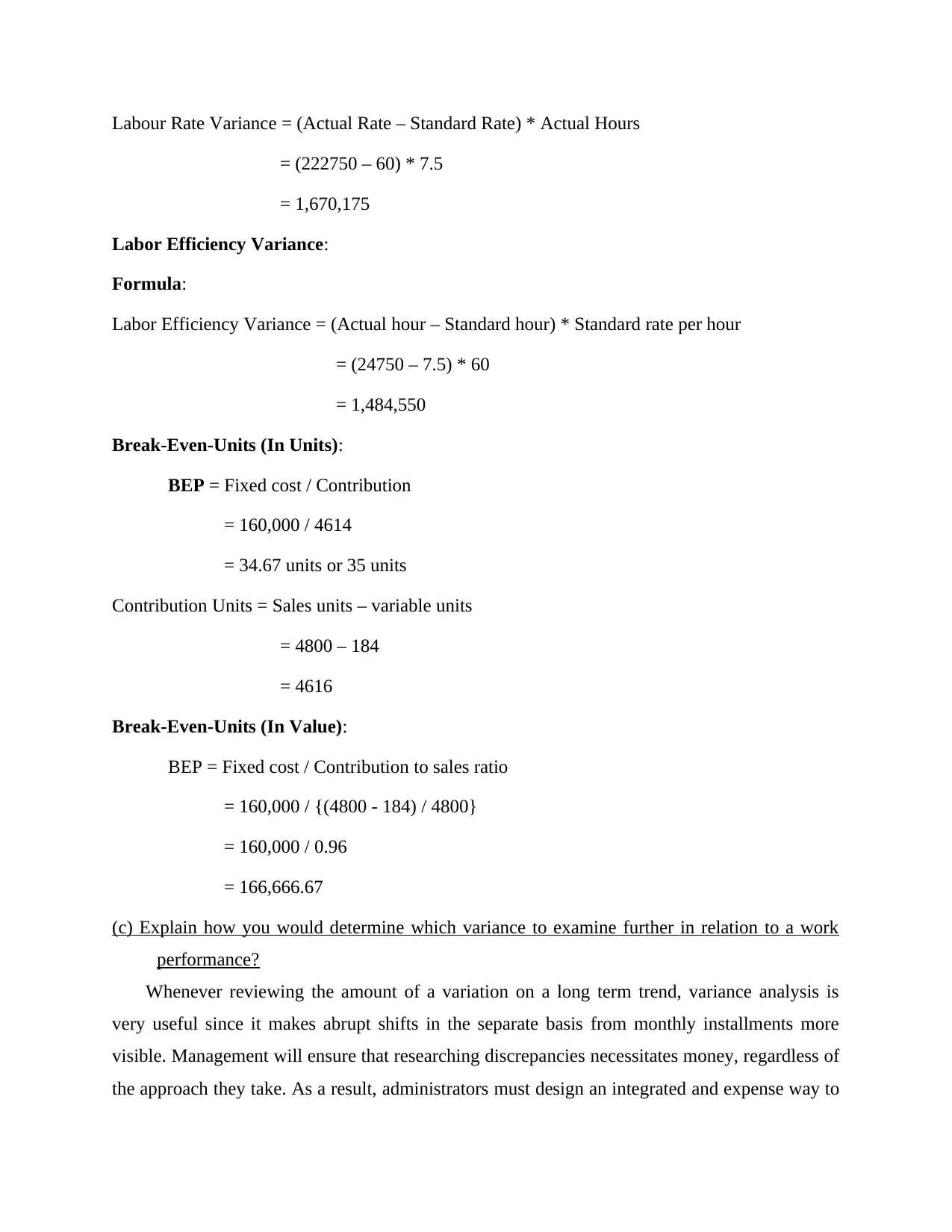
Labour Rate Variance = (Actual Rate – Standard Rate) * Actual Hours
= (222750 – 60) * 7.5
= 1,670,175
Labor Efficiency Variance:
Formula:
Labor Efficiency Variance = (Actual hour – Standard hour) * Standard rate per hour
= (24750 – 7.5) * 60
= 1,484,550
Break-Even-Units (In Units):
BEP = Fixed cost / Contribution
= 160,000 / 4614
= 34.67 units or 35 units
Contribution Units = Sales units – variable units
= 4800 – 184
= 4616
Break-Even-Units (In Value):
BEP = Fixed cost / Contribution to sales ratio
= 160,000 / {(4800 - 184) / 4800}
= 160,000 / 0.96
= 166,666.67
(c) Explain how you would determine which variance to examine further in relation to a work
performance?
Whenever reviewing the amount of a variation on a long term trend, variance analysis is
very useful since it makes abrupt shifts in the separate basis from monthly installments more
visible. Management will ensure that researching discrepancies necessitates money, regardless of
the approach they take. As a result, administrators must design an integrated and expense way to
= (222750 – 60) * 7.5
= 1,670,175
Labor Efficiency Variance:
Formula:
Labor Efficiency Variance = (Actual hour – Standard hour) * Standard rate per hour
= (24750 – 7.5) * 60
= 1,484,550
Break-Even-Units (In Units):
BEP = Fixed cost / Contribution
= 160,000 / 4614
= 34.67 units or 35 units
Contribution Units = Sales units – variable units
= 4800 – 184
= 4616
Break-Even-Units (In Value):
BEP = Fixed cost / Contribution to sales ratio
= 160,000 / {(4800 - 184) / 4800}
= 160,000 / 0.96
= 166,666.67
(c) Explain how you would determine which variance to examine further in relation to a work
performance?
Whenever reviewing the amount of a variation on a long term trend, variance analysis is
very useful since it makes abrupt shifts in the separate basis from monthly installments more
visible. Management will ensure that researching discrepancies necessitates money, regardless of
the approach they take. As a result, administrators must design an integrated and expense way to
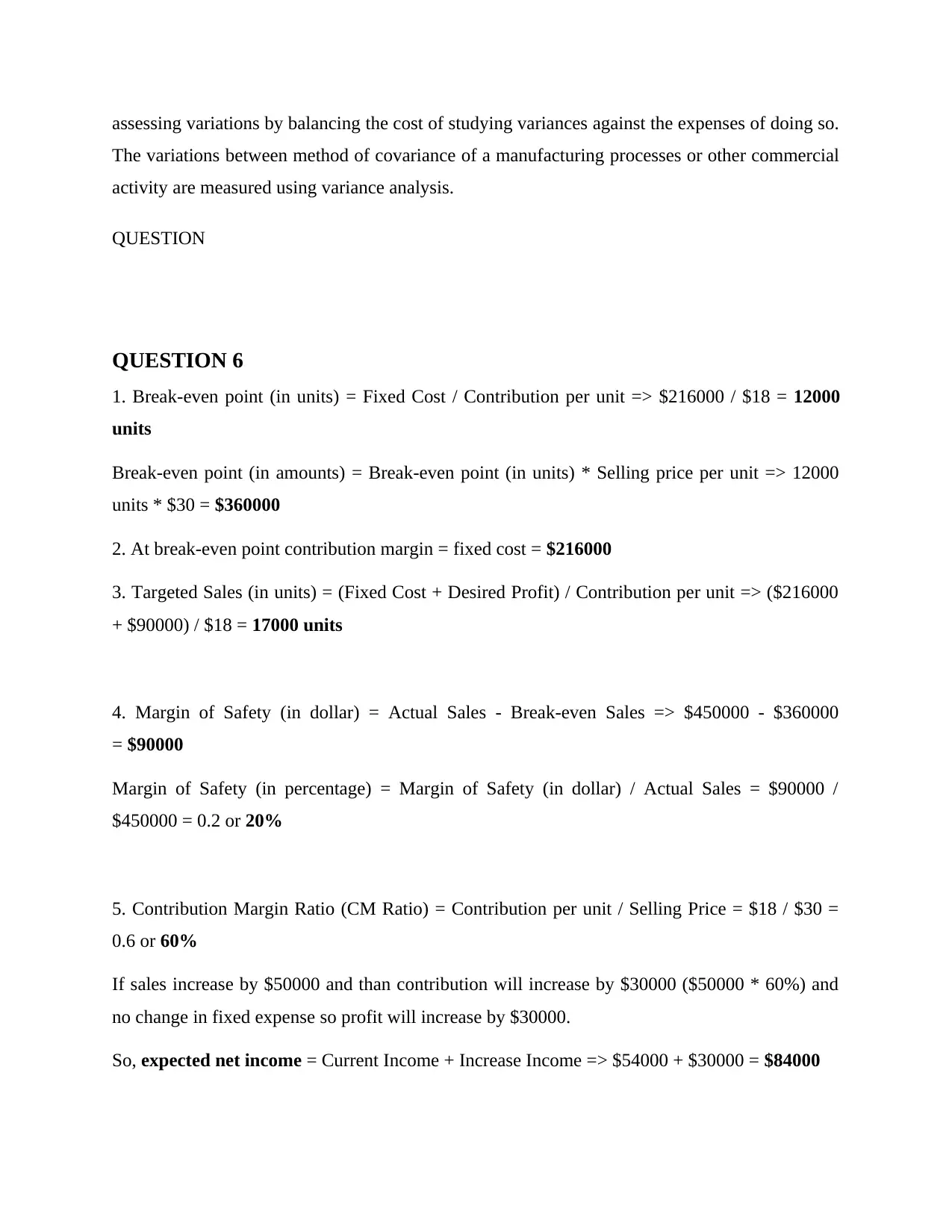
assessing variations by balancing the cost of studying variances against the expenses of doing so.
The variations between method of covariance of a manufacturing processes or other commercial
activity are measured using variance analysis.
QUESTION
QUESTION 6
1. Break-even point (in units) = Fixed Cost / Contribution per unit => $216000 / $18 = 12000
units
Break-even point (in amounts) = Break-even point (in units) * Selling price per unit => 12000
units * $30 = $360000
2. At break-even point contribution margin = fixed cost = $216000
3. Targeted Sales (in units) = (Fixed Cost + Desired Profit) / Contribution per unit => ($216000
+ $90000) / $18 = 17000 units
4. Margin of Safety (in dollar) = Actual Sales - Break-even Sales => $450000 - $360000
= $90000
Margin of Safety (in percentage) = Margin of Safety (in dollar) / Actual Sales = $90000 /
$450000 = 0.2 or 20%
5. Contribution Margin Ratio (CM Ratio) = Contribution per unit / Selling Price = $18 / $30 =
0.6 or 60%
If sales increase by $50000 and than contribution will increase by $30000 ($50000 * 60%) and
no change in fixed expense so profit will increase by $30000.
So, expected net income = Current Income + Increase Income => $54000 + $30000 = $84000
The variations between method of covariance of a manufacturing processes or other commercial
activity are measured using variance analysis.
QUESTION
QUESTION 6
1. Break-even point (in units) = Fixed Cost / Contribution per unit => $216000 / $18 = 12000
units
Break-even point (in amounts) = Break-even point (in units) * Selling price per unit => 12000
units * $30 = $360000
2. At break-even point contribution margin = fixed cost = $216000
3. Targeted Sales (in units) = (Fixed Cost + Desired Profit) / Contribution per unit => ($216000
+ $90000) / $18 = 17000 units
4. Margin of Safety (in dollar) = Actual Sales - Break-even Sales => $450000 - $360000
= $90000
Margin of Safety (in percentage) = Margin of Safety (in dollar) / Actual Sales = $90000 /
$450000 = 0.2 or 20%
5. Contribution Margin Ratio (CM Ratio) = Contribution per unit / Selling Price = $18 / $30 =
0.6 or 60%
If sales increase by $50000 and than contribution will increase by $30000 ($50000 * 60%) and
no change in fixed expense so profit will increase by $30000.
So, expected net income = Current Income + Increase Income => $54000 + $30000 = $84000
⊘ This is a preview!⊘
Do you want full access?
Subscribe today to unlock all pages.

Trusted by 1+ million students worldwide
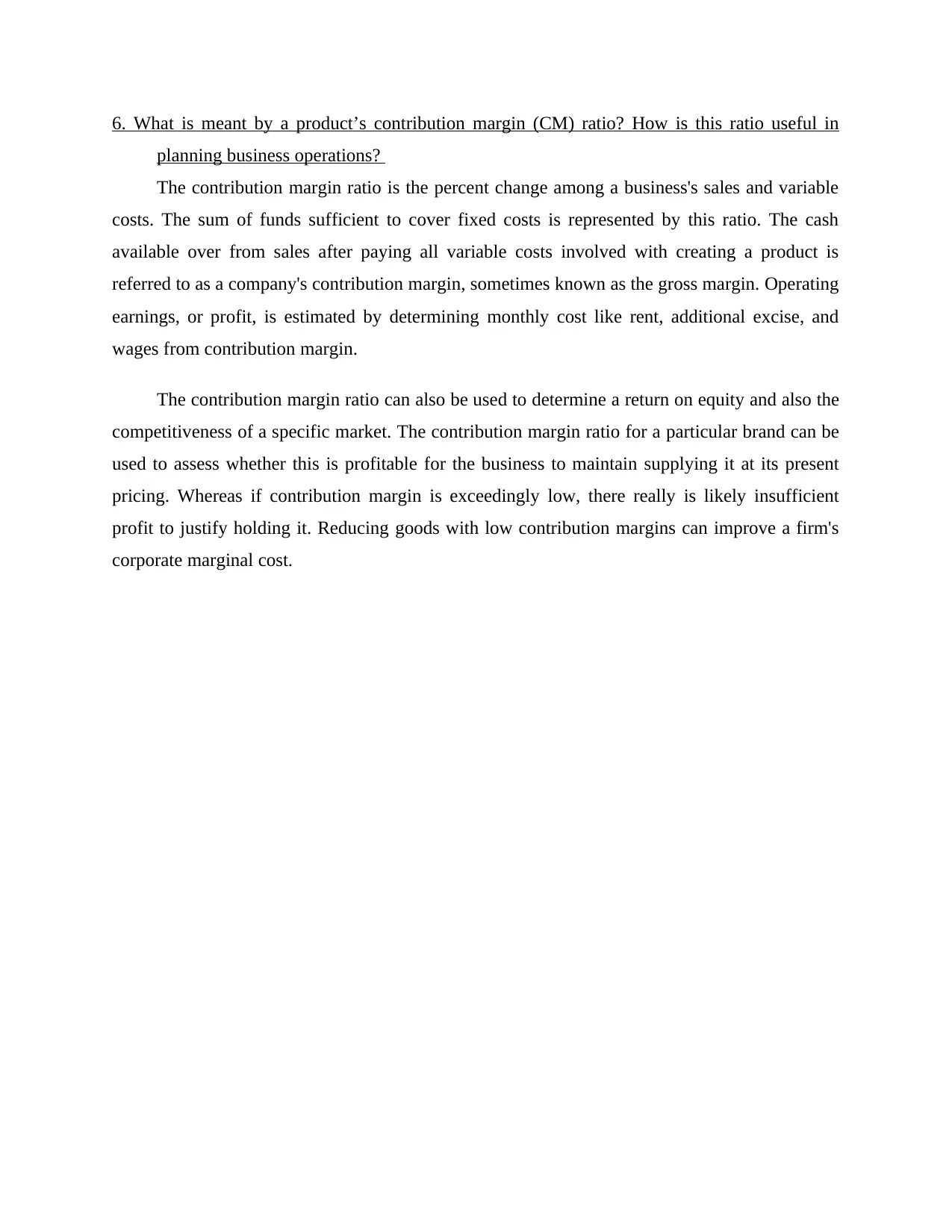
6. What is meant by a product’s contribution margin (CM) ratio? How is this ratio useful in
planning business operations?
The contribution margin ratio is the percent change among a business's sales and variable
costs. The sum of funds sufficient to cover fixed costs is represented by this ratio. The cash
available over from sales after paying all variable costs involved with creating a product is
referred to as a company's contribution margin, sometimes known as the gross margin. Operating
earnings, or profit, is estimated by determining monthly cost like rent, additional excise, and
wages from contribution margin.
The contribution margin ratio can also be used to determine a return on equity and also the
competitiveness of a specific market. The contribution margin ratio for a particular brand can be
used to assess whether this is profitable for the business to maintain supplying it at its present
pricing. Whereas if contribution margin is exceedingly low, there really is likely insufficient
profit to justify holding it. Reducing goods with low contribution margins can improve a firm's
corporate marginal cost.
planning business operations?
The contribution margin ratio is the percent change among a business's sales and variable
costs. The sum of funds sufficient to cover fixed costs is represented by this ratio. The cash
available over from sales after paying all variable costs involved with creating a product is
referred to as a company's contribution margin, sometimes known as the gross margin. Operating
earnings, or profit, is estimated by determining monthly cost like rent, additional excise, and
wages from contribution margin.
The contribution margin ratio can also be used to determine a return on equity and also the
competitiveness of a specific market. The contribution margin ratio for a particular brand can be
used to assess whether this is profitable for the business to maintain supplying it at its present
pricing. Whereas if contribution margin is exceedingly low, there really is likely insufficient
profit to justify holding it. Reducing goods with low contribution margins can improve a firm's
corporate marginal cost.
Paraphrase This Document
Need a fresh take? Get an instant paraphrase of this document with our AI Paraphraser
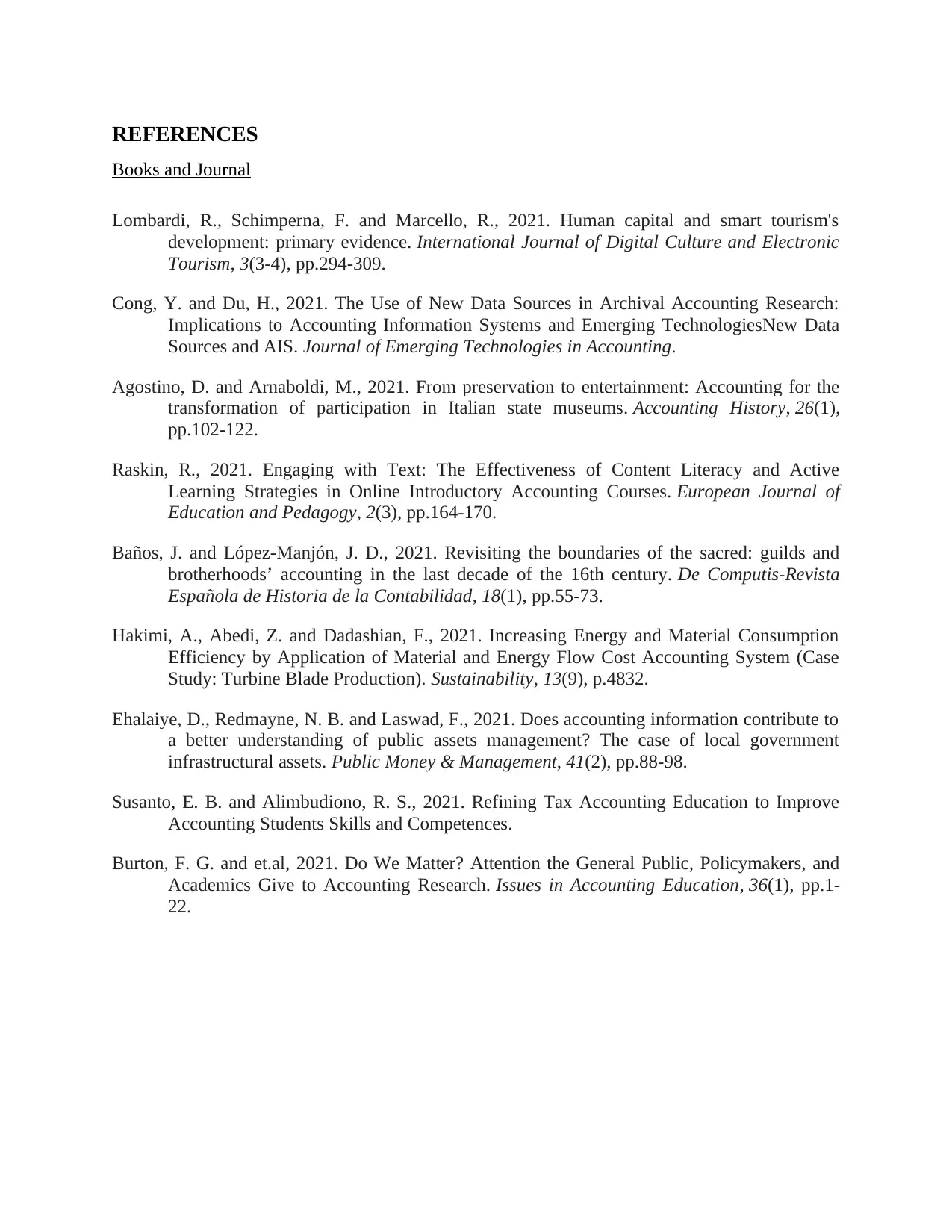
REFERENCES
Books and Journal
Lombardi, R., Schimperna, F. and Marcello, R., 2021. Human capital and smart tourism's
development: primary evidence. International Journal of Digital Culture and Electronic
Tourism, 3(3-4), pp.294-309.
Cong, Y. and Du, H., 2021. The Use of New Data Sources in Archival Accounting Research:
Implications to Accounting Information Systems and Emerging TechnologiesNew Data
Sources and AIS. Journal of Emerging Technologies in Accounting.
Agostino, D. and Arnaboldi, M., 2021. From preservation to entertainment: Accounting for the
transformation of participation in Italian state museums. Accounting History, 26(1),
pp.102-122.
Raskin, R., 2021. Engaging with Text: The Effectiveness of Content Literacy and Active
Learning Strategies in Online Introductory Accounting Courses. European Journal of
Education and Pedagogy, 2(3), pp.164-170.
Baños, J. and López-Manjón, J. D., 2021. Revisiting the boundaries of the sacred: guilds and
brotherhoods’ accounting in the last decade of the 16th century. De Computis-Revista
Española de Historia de la Contabilidad, 18(1), pp.55-73.
Hakimi, A., Abedi, Z. and Dadashian, F., 2021. Increasing Energy and Material Consumption
Efficiency by Application of Material and Energy Flow Cost Accounting System (Case
Study: Turbine Blade Production). Sustainability, 13(9), p.4832.
Ehalaiye, D., Redmayne, N. B. and Laswad, F., 2021. Does accounting information contribute to
a better understanding of public assets management? The case of local government
infrastructural assets. Public Money & Management, 41(2), pp.88-98.
Susanto, E. B. and Alimbudiono, R. S., 2021. Refining Tax Accounting Education to Improve
Accounting Students Skills and Competences.
Burton, F. G. and et.al, 2021. Do We Matter? Attention the General Public, Policymakers, and
Academics Give to Accounting Research. Issues in Accounting Education, 36(1), pp.1-
22.
Books and Journal
Lombardi, R., Schimperna, F. and Marcello, R., 2021. Human capital and smart tourism's
development: primary evidence. International Journal of Digital Culture and Electronic
Tourism, 3(3-4), pp.294-309.
Cong, Y. and Du, H., 2021. The Use of New Data Sources in Archival Accounting Research:
Implications to Accounting Information Systems and Emerging TechnologiesNew Data
Sources and AIS. Journal of Emerging Technologies in Accounting.
Agostino, D. and Arnaboldi, M., 2021. From preservation to entertainment: Accounting for the
transformation of participation in Italian state museums. Accounting History, 26(1),
pp.102-122.
Raskin, R., 2021. Engaging with Text: The Effectiveness of Content Literacy and Active
Learning Strategies in Online Introductory Accounting Courses. European Journal of
Education and Pedagogy, 2(3), pp.164-170.
Baños, J. and López-Manjón, J. D., 2021. Revisiting the boundaries of the sacred: guilds and
brotherhoods’ accounting in the last decade of the 16th century. De Computis-Revista
Española de Historia de la Contabilidad, 18(1), pp.55-73.
Hakimi, A., Abedi, Z. and Dadashian, F., 2021. Increasing Energy and Material Consumption
Efficiency by Application of Material and Energy Flow Cost Accounting System (Case
Study: Turbine Blade Production). Sustainability, 13(9), p.4832.
Ehalaiye, D., Redmayne, N. B. and Laswad, F., 2021. Does accounting information contribute to
a better understanding of public assets management? The case of local government
infrastructural assets. Public Money & Management, 41(2), pp.88-98.
Susanto, E. B. and Alimbudiono, R. S., 2021. Refining Tax Accounting Education to Improve
Accounting Students Skills and Competences.
Burton, F. G. and et.al, 2021. Do We Matter? Attention the General Public, Policymakers, and
Academics Give to Accounting Research. Issues in Accounting Education, 36(1), pp.1-
22.
1 out of 11